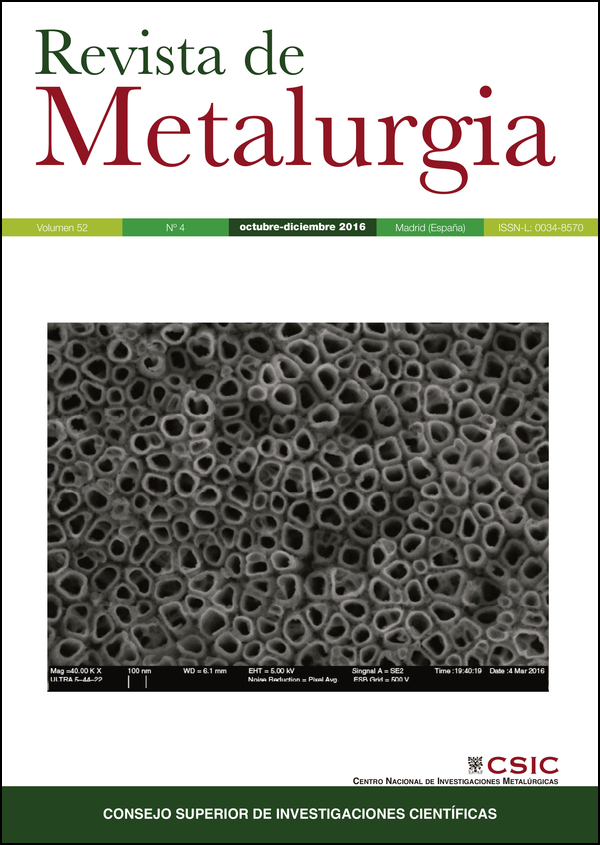Synthesis of novel ionic liquids and evaluation of their leaching performance in the recovery of copper and zinc from industrial brass slag
DOI:
https://doi.org/10.3989/revmetalm.082Keywords:
Copper, Ionic liquid, Leach, Recovery, Synthesis, ZincAbstract
Imidazolium-based ionic liquids, 1,3-dibenzylimidazolium trifluoroacetate, 1-benzyl-3-ethylimidazolium trifluoroacetate and 1-benzyl-3-propylimidazolium trifluoroacetate were prepared by simple methods, when compared with those in literature sources, and characterized by IR, NMR and GC-MS and LC-MS. These ILs (Ionic Liquids) were employed as leaching agents in the treatment of industrial copper and zinc bearing slag for the recovery of metals. Results showed that synthesized all novel ionic liquids meet the standard specifications of an ionic liquid. Metal recovery rates decrease with time except for zinc dissolution in 1,3-dibenzylimidazolium trifluoroacetate. 1,3-dibenzylimidazolium trifluoroacetate, when compared with others, is a more effective leaching agent for the treatment of copper and zinc bearing brass slag. Metal recovery rates achieved with this IL are 62.58% for zinc and 24.95% for copper.
Downloads
References
Abbott, A.P., Capper, G., Davies, D.L., Shikotra, P. (2006). Processing metal oxides using ionic liquids. Trans. Inst. Min. Met. C 115 (1), 15–18. https://doi.org/10.1179/174328506x91293
Abbott, A.P., Frisch, G., Hartley, J., Karl, S. (2011). Processing of metals and metal oxides using ionic liquids. Green Chem. 13 (3), 471–481. https://doi.org/10.1039/c0gc00716a
Chai, Y., Wang, L., Sun, H., Guo, C., Pan, Y. (2012). Gas-phase chemistry of benzyl cations in dissociation of N-benzylammonium and N-benzyliminium ions studied by mass spectrometry. J. Am. Soc. Mass Spectrom. 23 (5), 823–833. https://doi.org/10.1007/s13361-012-0344-8 PMid:22367690
Dong, T.G., Hua, Y.X., Zhang, Q.B., Zhou, D.G. (2009). Leaching of chalcopyrite with Br.nsted acidic ionic liquid. Hydrometallurgy 99 (1–2), 33–38. https://doi.org/10.1016/j.hydromet.2009.06.001
Earle, M.J., Seddon, K.R. (2000). Ionic liquids: Green solvents for the future. Pure Appl. Chem. 72 (7), 1391–1398. https://doi.org/10.1351/pac200072071391
Hajipour, A.R., Rafiee, F. (2009). Basic Ionic Liquids. A Short Review. J. Iran. Chem. Soc. 6 (4), 647–678. https://doi.org/10.1007/BF03246155
Keskin, S., Kayrak-Talay, D., Akman, U., Hortacsu, O. (2007). A review of ionic liquids towards supercritical fluid applications. J. Supercrit. Fluid. 43 (1), 150–180. https://doi.org/10.1016/j.supflu.2007.05.013
Kilicarslan, A., Saridede, M.N., Stopic, S., Friedrich, B. (2014). Use of ionic liquid in leaching process of brass wastes for copper and zinc recovery. Int. J. Miner. Metall. Mater. 21 (2), 138–143. https://doi.org/10.1007/s12613-014-0876-y
Kulkarni, P.S., Branco, L.C., Crespo, J.G., Nunes, M.C., Raymundo, A., Afonso, C.A. (2007). Comparison of physicochemical properties of new ionic liquids based on imidazolium, quaternary ammonium, and guanidinium cations. Chem. Eur. J. 13 (30), 8478–8488. https://doi.org/10.1002/chem.200700965 PMid:17665379
Laus, G., Bentivoglio, G., Schottenberger, H., Kahlenberg, V., Kopacka, H., R.der, T., Sixta, H. (2005). Ionic liquids: Current developments, potential and drawbacks for industrial applications. Lenzinger Berichte 84, 71–85. https://aaltodoc.aalto.fi/handle/123456789/22441.
Ma, C.H., Zu, Y.G., Yang, L., Li, J. (2015). Two solid-phase recycling method for basic ionic liquid [C4mim]Ac by macroporous resin and ion exchange resin from Schisandra chinensis fruits extract. J. Chromatogr. B 976–977, 1–5. https://doi.org/10.1016/j.jchromb.2014.11.003 PMid:25463641
Tian, G.C., Li, J., Hua, Y.X. (2010). Application of ionic liquids in hydrometallurgy of nonferrous metals. Trans. Nonferrous Met. Soc. China 20 (3), 513–520. https://doi.org/10.1016/S1003-6326(09)60171-0
Published
How to Cite
Issue
Section
License
Copyright (c) 2016 Consejo Superior de Investigaciones Científicas (CSIC)

This work is licensed under a Creative Commons Attribution 4.0 International License.
© CSIC. Manuscripts published in both the printed and online versions of this Journal are the property of Consejo Superior de Investigaciones Científicas, and quoting this source is a requirement for any partial or full reproduction.
All contents of this electronic edition, except where otherwise noted, are distributed under a “Creative Commons Attribution 4.0 International” (CC BY 4.0) License. You may read the basic information and the legal text of the license. The indication of the CC BY 4.0 License must be expressly stated in this way when necessary.
Self-archiving in repositories, personal webpages or similar, of any version other than the published by the Editor, is not allowed.
















